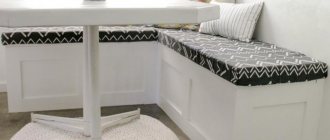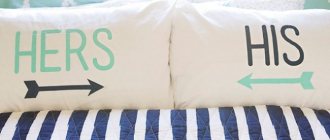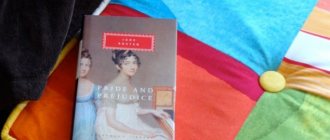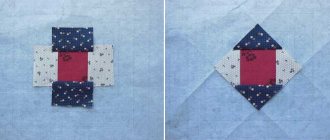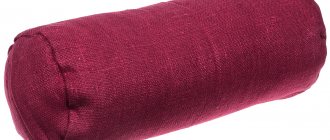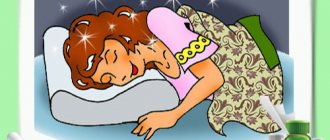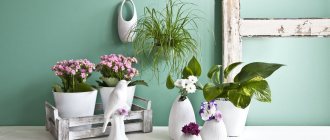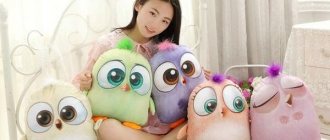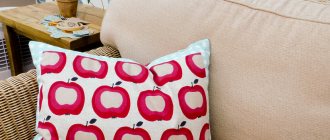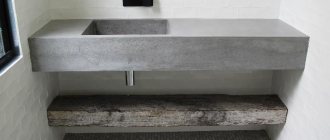A little history and magic
But it was not always so. Initially, pillows were large stones that were placed under heads to maintain hairstyles while sleeping.
The first soft pillows first appeared in Ancient Greece, where local sybarites basked in bed almost 24 hours a day.
A little later, pillows began to be considered magical objects. Until now, girls tell fortunes about their betrothed with the help of this simple object.
Small bags with fragrant herbs are designed to ward off evil spirits and attract the most pleasant dreams, reduce headaches and speed up recovery during illness.
Types of pillows
Types and ideas of DIY pillows are divided into several large groups.
Depending on their purpose, pillows can have a decorative and practical role, be sofa or floor.
How to sew a hug pillow?
Stores often sell excellent quality Dutch knitwear from which dolls are made. It is very easy to use and gives the product warmth and coziness. How to sew a hug pillow in the shape of a large doll? Just follow a few recommendations:
- choose knitwear of various colors: the body and head are pastel colors;
- clothes for a doll can emphasize female or male gender;
- make your hair from woolen or synthetic yarn;
- the filling of the doll can be made of foam rubber or padding polyester;
- Provide the body with a cover so that the fibers do not penetrate outside;
- Sew clothes onto the doll in parts, rather than pulling them all on the body at once.
Decorative pillows
Sofa decorative pillows can be placed not only on sofas; they often decorate armchairs, couches, chairs, and beds.
We recommend reading:
- DIY polymer clay jewelry: review of the best master class with step-by-step instructions for beginners (150 photos of original ideas)
DIY polymer clay flowers (120 photos of the best ideas) - simple instructions with full description + master class and video tutorials
Quilling for beginners (200 photos) - step-by-step instructions with description. The best master class on creating quilling crafts with your own hands
Most often, these are quite rigid products; they are not intended to create comfortable conditions for humans and serve as an interior item.
Decorative practical pillows can have a variety of shapes. They are often made in the shape of hearts, dogs and cats, cars and cartoon characters. You can sleep on them, but most often they are used to decorate a room or play with children.
pattern, how to sew it yourself :: SYL.ru
In our world, many people suffer from loneliness and lack of physical intimacy. Although hugs are necessary for all of us, because they give us a feeling of confidence and security. There is a solution - a hug pillow. It was offered by manufacturers of sleep products, who caught the latest trends in society in time.
There is a solution - this is a hug pillow, it was proposed by manufacturers of sleep products, who caught the latest trends in society.
A little history
Hugs came to us from Japan. It was in the Land of the Rising Sun that a large cylindrical pillow was used to separate the sleeping places of numerous relatives who huddled in one small hospitable house. “What is the name of the hug pillow?” - you ask, and the Japanese will answer - “dakimakura”.
Fans of such original sleeping accessories never part with them on trips and long journeys. Dakimakura helps relieve stress, fatigue and creates a cozy homely atmosphere.
An original gift for a loved one
European manufacturers have gone further than their colleagues from the East; they have created a sleeping accessory that hugs its owner. A pillow with a hand is not a joke, but a real thing that will not just be a pleasant gift, but will also provide comfort. A special feature of the pillow is that it can be worn not only in a pillowcase, it can be replaced with real clothes of an adult, this will only add bright emotions.
What is this pillow for?
The hug pillow is a constant companion on long trips and trips for many people. It can protect from cold, loneliness and remind you of the comfort of your home. By making it yourself, you can give a nice gift for March 8th and the birthday of a loved one.
And if you choose a larger size, you can place it along the entire body. The pillows are so flexible that they easily change shape, adapting to a person’s figure. They can be placed not only under the arms or legs, but also under a large belly. Such a gift will be a pleasant accessory for a pregnant girl. Moreover, it is very easy to care for.
Types of pillows
The market offers “hug pillows” that are completely different in shape; they come in the shape of the letter G, I, U or G. When purchasing a pillow, you need to decide which one will be the most comfortable for its owner. For example, a U-shaped pillow may not be suitable for a pregnant girl, because it is too large, and she needs to calculate whether there will be enough room for her husband?
But the hug pillow, the pattern of which is similar to the number 7, has only one side, so it will absolutely not interfere with a pregnant woman who will be hugged by her beloved man from the other side.
I-shape cuddles will be equally beneficial for men and women, and they are also comfortable for two people to sleep on. For a small child it can be used as a restraint. However, it should keep its shape and be of medium elasticity.
There are pillows for children in the shape of two hands or a favorite animal. The child will sleep peacefully while the mother is away.
DIY hug pillow: manufacturing features
Excellent products are made from high-quality knitwear, and this fabric is also very convenient to work with. Original pillows in the form of dolls are made from knitwear that are especially soulful. Clothes are simply sewn onto the “hug”, and the child can not only hug it while sleeping, but also play. For such products, it is also appropriate to use aromatic oils with a calming effect, for example, lavender. You just need to drop a few drops on the top of the head of a kind of pillow doll.
A wide variety of fillers can be used for stuffing. One of the best options may be a drainer. This is sheep's wool of natural color, it undergoes washing and primary processing. Initially, a pillow made from such material will be fluffy, but over time it will settle and make the “hug” plastic, and then the product will easily take the required position.
Sewing instructions
Most often, pillows are made in the shape of the letter U, C or G, while its ends can be of completely different shapes and lengths. A hand-made hug pillow (patterns are made from whatman paper or wallpaper) should be about 1.5 m in length and at least 30-40 cm wide.
The finished paper sample is laid out on a fabric folded in half and traced. When starting to cut out a product, it is worth remembering the seam allowances. It is best to choose a natural and dense material that will not cause irritation. As for color, dark shades are preferable, so the pillow will not get dirty very quickly, but you can also think about a bright-colored pillowcase, in which case the product will become more convenient to use.
On the wrong side, taking into account the allowances, a stitch is made along the contour of the product. You need to leave about 40 cm to fill the pillow. When the handwork is completed, the edges are sewn on a machine, not forgetting the hole for filling.
Next, you need to remove the basting and turn the product right side out. To give the hug pillow a neat appearance, the fabric is smoothed with an iron. After this, you need to fill the pillow: synthetic padding quickly cakes, holofiber is more practical, but natural fillers are environmentally friendly, the main thing is that they do not cause an allergic reaction. It is most convenient to start stuffing from the edges. Once completed, the hole is closed with a hidden stitch. A bright and original product will not only hug you when you feel sad, it can become a bright decoration for your bed or sofa.
www.syl.ru
Practical pillows
These pillows are used for relaxation. They are usually square or rectangular in shape and are characterized by softness and comfort.
The only decoration of such pillows are pillowcases. For the most part, these pillows spend most of their life in bed drawers or under covers.
How to choose fabric, filling and accessories
Before sewing a beautiful product for decoration, including a pillow, you should carefully consider its filling and the material from which it will be made. It is important to choose fabrics that will be as easy to care for as possible. Moreover, the material should not become electrified during use and attract dust. Ideal for this would be:
- Silk, satin and similar materials;
- Satin, flannel, calico fabric and linen material;
- Fabric used for upholstering furniture or chairs.
You can use the same material as when upholstering furniture.
For a more budget-friendly and original option, you can use old clothes or parts of them. The pillow will be in a patchwork style and no one will even guess that it contains old T-shirts, sweaters and pants.
Square decorative item made of silk with an oriental motif
Filler
If you have no idea what to stuff your future product with, then you need to familiarize yourself with the list of popular materials. You should choose those compositions that will not begin to clump after a certain time. Based on this, padding polyester and cotton wool disappear immediately. You should also not use feathers or down for these purposes, as these materials do not hold their shape well and are suitable for sleeping products.
Fillers
The most preferred options are:
- Holofiber, which can maintain its characteristics for 10 years of operation;
- Silicone, or rather its granules. Ideal for children's products. They are practical in that they can be taken out to wash the pillow and put back in;
- Natural materials such as hop cones, buckwheat husks, aromatic herbs.
Natural filler
Accessories
To sew a decorative pillow yourself by hand or on a machine, you will need threads of a certain color and number. Usually from 40 and above. In order to embroider on the product you will need floss. If the base of the pillow is knitted, then use almost any yarn. If the product cover is removable, it may require buttons or a zipper.
You will be interested in this Ready-made patterns and sewing procedure for dog harnesses with your own hands Threads for floss will be an excellent decoration for a pillow
Floor cushions
Such items are rarely found in ordinary Russian houses, unless they highlight the interior in an oriental style. They are quite tough and bright.
We recommend reading:
DIY paper orchid - a review of the best ideas and tips from craftswomen. Step-by-step instructions + master class (photo + video lessons)- DIY paper hyacinth: the best master class for beginners with step-by-step instructions and diagrams from A to Z (130 photos)
Paper stars - instructions on how to quickly and easily learn how to make beautiful stars with your own hands (100 photos of finished works)
Pillow shapes
Traditional rectangular pillows can be combined with cylindrical bolsters or round puffs. Both of them are mainly used to decorate the room.
Small hard pads are called dumochek. They are richly decorated with embroidery, fringe, tassels,
Figured pillows are usually made in the shape of numbers, letters or hearts, which until recently were in great demand.
You can make a pillow at home in absolutely any shape, if you wish.
Fabric for pillow
Any fabric can become the face of the pillow. It could be:
- Practical and inexpensive chintz or satin. It will be a great addition to your sleeping pillow.
- Expensive and lightweight silk, which will perfectly cool the skin during the hot season.
- Thick linen that will give a feeling of care and durability.
- Wool that will gently warm you on cold days and nights and gently heal the body with any touch.
- The tapestry will be a wonderful addition to any decorative pillow.
We recommend reading:
A paper crown is a simple instruction for creating original jewelry with your own hands. Templates, diagrams, master class, exclusive design (110 photos)Weaving from newspaper tubes for beginners: the best free master class, with step-by-step instructions. Photos, diagrams, unusual ideas, videos
Paper rose - how to make it yourself? Step-by-step instructions, original ideas, photos, videos, master class
Teak, fleece, and velvet are often used as pillowcases.
If you don’t want to buy new fabric, then any scraps you can find in the house will help you solve the question of what you can make a pillow out of. It could even be old shirts or jeans. Moreover, the patchwork method is coming back into fashion.
Where did it appear and why is it needed?
Hugging pillows have become very popular only in recent years, but they first appeared quite a long time ago. In the mid-20th century, these products were produced and actively used in Japan, and then in Thailand.
When a large number of guests came to the house, the owners living in small housing had to invite them to spend the night in the same bed with them. Long hug pillows were used as “dividers.” This was a guarantee of compliance with the rules of decency in such situations.
Today, hug pillows are used to provide a feeling of security and comfort. They are appreciated by lonely people or those whose loved ones are far away. Tactile contact is always necessary. They improve your mood, calm you down, and make you feel comfortable.
The pillows are large in size as they can be wrapped around all limbs.
The device is used for emotional relief. The situation is further improved by a fun design, selected according to the person’s personal preferences.
Another function of the products is to retain heat, which makes them convenient to use in cold seasons. They help achieve muscle relaxation after a long day of work.
Filler
Decorative pillows are usually stuffed with synthetic fillers such as padding polyester, holofiber, and foam rubber.
For products intended for sleeping, more expensive fillings are used: feathers, down, wool. Buckwheat husk is becoming a popular filling.
When selecting materials, simple instructions are used on how to make a pillow correctly: loose fillings should be wrapped in thick fabric; The thinner the filler, the softer the fabric of the cover should be.
Sewing pillows
The whole process can be divided into several stages. This includes selecting the necessary tools and purchasing materials, creating a pattern, cutting fabric, sewing individual elements, stuffing, sewing up seams, and making a decorative pillowcase.
Photos of how to make a pillow will help you better understand the process of making a soft product.
Some tips
Making a simple pattern will not cause any difficulties, but for more complex shapes you can use ready-made templates that are easy to find on the Internet or in specialized magazines.
Don't forget about seam allowances.
A standard pillowcase has a size of 70*70 or 70*50, so if you don’t want to make separate covers, it’s better to make a pillow based on these characteristics.
To reduce the number of seams, a rectangular pillow can be sewn not from two fabrics, but from one, making a fold in the middle of the fabric.
It is much more convenient to fill a pillow from synthetic materials, but fluff can scatter throughout the room if you move it carelessly.
It is carefully poured from the old pillow or factory packaging through the holes of the old and new down storage sewn together.
A small incision is left to fill the pillow.
If you plan to sew in a zipper, then this element should be selected with tiny locks and teeth. Otherwise, the zipper can dig into the skin and cause a lot of inconvenience.
Padding
Read more about stuffing. First of all, you need to look at the properties of the filler itself, since this is the main characteristic of the future pillow. You can stuff the product with padding polyester or knitted tape, cotton wool and other materials that are quite cheap. In cases where stuffing is required specifically for a decorative model, it is important to approach the process of choosing filler more seriously.
You might be interested in DIY patterns and sewing of the Tilda cat
Appearance of holofiber
The main properties that the material must have:
- Sufficient elasticity. When pressed, the product should quickly restore its shape and not leave dents if people sleep on it;
- Breathability. All materials, including those from which the base, cover and padding are made, must allow air to pass through well and allow the skin to breathe;
- Hypoallergenic. All these materials must also be safe for human health and not cause allergies or skin irritation;
- Easy to care for. The pillowcase, cover and pillow itself should be easy to wash and machine washable.
Sintepon
By type, padding is divided into three categories:
- Artificial material;
- Natural material of plant origin;
- Natural material of animal origin.
Hop cones for stuffing
Artificial padding
Artificial materials have a number of properties that put them on the same level as natural ones. Moreover, they also have their own distinctive characteristics. This composition does not allow dust mites to develop and will not cause allergies. Synthetic materials are easier to wash and dry quickly.
Foam pillow
The most commonly used artificial paddings are padding polyester and holofiber. The first option is budget. Sintepon is used not only for this, but also in the manufacture of clothing.
Important! A significant disadvantage of padding polyester is that it quickly falls into clumps and does not recover its shape well. If such a pillow is actively used, then tubercles will quickly appear on it, and its surface will become hard.
Pillow in the shape of a scops owl
That is why the best choice would be holofiber, a non-woven material consisting of interwoven polyester fibers. The space between the fibers has a porous structure and is filled with air, which makes holofiber light and warm. In addition, the composition has the following characteristics:
- Removal of moisture and water;
- Air permeability;
- High service life;
- No static electricity;
- Easy to care for and easy to machine;
- No smell.
Toy pillows in the form of cats
Vegetable stuffing
Plant materials are often used to form decorative pillows or sleep products. Among the most popular options:
- Dry herbs and algae;
- Leaves of herbs such as mint or lemon balm;
- Hop cones;
- Buckwheat husk.
Herbs can also be used as a filler
. Important! In many cases, such stuffing will be beneficial to health, will add some originality to the product and a pleasant smell of herbs, which will spread throughout the room.
Cotton is also often used. A pillow stuffed with cotton will be hypoallergenic, and harmful organisms and insects will not breed in it. If you stuff the cotton correctly and take care of the pillow, you can extend its service life.
Product with cotton
Animal stuffing
Down and feathers from birds (chicken, geese, swans, ducks) are considered traditional for animal stuffing. The pillows are light, soft, and quickly take shape after deformation. One drawback is that it is not advisable for people suffering from dust mite allergies to sleep on them. The thing is that over time, microorganisms can develop in such stuffing that can cause suffocation attacks in allergy sufferers. But this can also be avoided. It is enough to properly care for the item, constantly wash, dry and air it.
Sheep wool padding
In addition, you can stuff the pillow with camel or sheep wool. It will become not only comfortable, but also therapeutic, because camel hair helps people suffering from radiculitis get rid of symptoms. This material also has disadvantages: heavy weight and rapid rolling.
You might be interested in this: Patterns and sewing of blouses and dresses for peasant women
Important! You can also use unnecessary pieces of wool yarn or an old fur coat. It can be cut into pieces and distributed evenly over the base. Such a pillow will collect a lot of dust, so it should be washed or knocked out more often.
Camel hair pillow
Pillowcases
Making a pillowcase is the final stage of creating a pillow.
For decorative items, they try to match them to the color of the room’s decoration or use them to create bright accent spots. Such pillows are decorated with embroidery, direct and reverse appliqué, lace, tassels, and fringe.
Sleeping pillows are usually dressed in simple pillowcases made from natural fabrics.
Making a pillow with your own hands is not a difficult process at all, but the finished craft will bring many pleasant moments and can become a lovely piece of decor or a nice gift.
The history of the birth of the pillow
The hug pillow was first invented in Japan. Its shape resembles a Japanese sleeping pillow that you can hug and fall asleep soundly. It was complemented by a “hand” that seemed to hug its owner. This has nothing to do with the design of the product. Everything is thought out by the Japanese to the smallest detail.
This detail gives a comfortable state, allows you to feel the comfort and love of a loved one. Interestingly, the hug pillow can not only be placed in a special pillowcase, but also threaded into the sleeve of an adult’s clothing.
An excellent gift - such an interesting product in its design will appeal to the most biased person. You can sew images of hearts, cats and other cute characters on the pillow - this will once again remind your loved one of tender feelings. The advantage of this product is that it has a simple pattern. The hug pillow can be made from any pleasant material.
DIY pillow photo
Did you like the article?
1+
